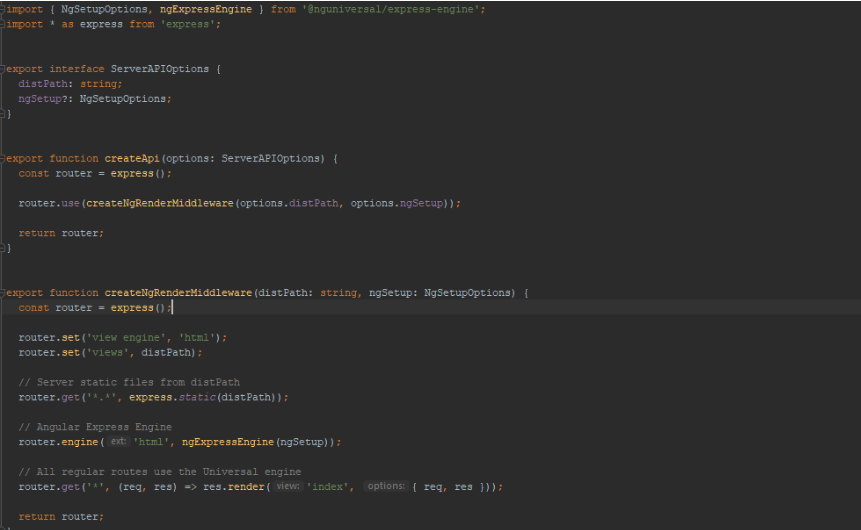Today, Angular Universal is competent in running equally well on almost all platforms. But most importantly, it can be run on a server as well. This qualifies Angular to a whole set of new capabilities, such as rendering angular to HTML from the server. The main purpose of Angular universal was to enable and run angular as a complete platform-independent application and it has since justified its existence.
Angular Universal once ‘was’ a standalone project but with the 4.0 version of Angular, Angular Universal got merged into the main framework. Since the merging, the Angular Universal ships together with the core angular packages. The names of these packages are platform-browser and platform-server.
What is a server-side rendering?
Angular responses to user actions while rendering pages in the DOM. A normal Angular application executes within the browser.
When an Angular Universal gets executed on the server, it generates static application pages that later get bootstrapped on the client. This gives users a chance to view the application layout before it becomes fully interactive. This also means that the application generally renders more quickly.
Rendering Angular on a Server
An Angular application is a Single-page App that runs in a client’s browser. Angular application is simply just an HTML parser. When the user creates its application, the application templates are parsed from HTML markup language to JavaScript language code. At the time of run-time in the browser, this JavaScript code will create the parsed HTML elements. But rendering that HTML requires a complete Angular framework to be downloaded.
Angular application is also capable of running on the node.js servers. Because of this, it is also possible to generate parsed HTML on the server. The result that the server can send to the client is a bunch of HTML templates.
Benefits of Server-side rendering
Here are three reasons to create a universal version of an application with Angular Universal:
- Improved performance on low-powered devices such as mobile.
Many low-powered devices execute JavaScript so poorly that the user experience is intolerable. Some devices may not support JavaScript processing at all. For such cases, the user may require a server-rendered, no-JavaScript version of the application. This version would, however, still have its limitations. But it is the only practical alternative for people who otherwise couldn’t use the app at all.
- Using First-contentful paint (FCP) for displaying the first page quickly.
For quality user engagement, the loading of the first page quickly is very important. An application may have to launch faster to engage with its users before they abandon it and decide to move on since it is estimated that 53 percent of mobile site visits are abandoned if pages take longer than 3 seconds to load.
With the use of Angular Universal, developers can generate first display pages for the applications that look like an app itself. These pages can display even if JavaScript is disabled since it is built in pure HTML. This supports navigation throughout the site using a router link even though it doesn’t handle browser events.
In the run-through, the user will serve a static version of the first display page to attain the visitor’s attention. At the same time, it’ll load a full Angular app behind it. The user views the near-instant performance from the first display pages and gets the full interactive experience after the app fully loads.
- Facilitate web crawlers on applications through search engine optimization (SEO)
Social media sites like Twitter, Instagram, and Facebook and search engine sites like Yahoo!, Google, and Bing rely on web crawlers. They use web crawlers to index the application content and make that content searchable on the web. These web crawlers may find it difficult to navigate and index highly-interactive applications as a human user could do.
With the use of Angular Universal, the user can generate a static version of its application that is easily linkable, searchable, and navigable without JavaScript. Since each URL returns a fully rendered page, Angular Universal also makes a site preview available for the visitors.

Difference in Angular Server-side rendering and Static Rendering
Angular Server-side rendering is a dynamic nature that will keep the company from requisite overhead prices. Many Angular Server-side rendering solutions do not flush early, it rather doubles the info being sent. In response, renderToString() is slow as it is single-threaded and synchronous.
Maintaining the Angular Server-side rendering correctly will involve building or finding an answer for applying memorization techniques, managing memory consumption, parting the caching and plenty of different considerations. The developer has to usually rebuild or process a similar application multiple times once its consumer is within the server.
Angular Server-side rendering is slower than simply serving static rendered content. Even though it produces HTML (hypertext mark-up language) on-demand for every address. However, if the user is able to place the extra work, Angular Server-side rendering + hypertext mark-up language caching will massively reduce the server render time. The side to Angular Server-side rendering is that the ability to reply to an additional complete set of requests, which is not feasible with static rendering. It also has the ability to drag additional knowledge. Pages that require a personalization square has to measure a concrete example of the same type. This may not work well with static rendering.
Conclusion
In this blog, we have explained the Angular Universal & Angular Side-server-rendering and why developers should use it to improvise user experience and what benefits it gives over static rendering. We hope that this information was useful to you in more than just a way.




